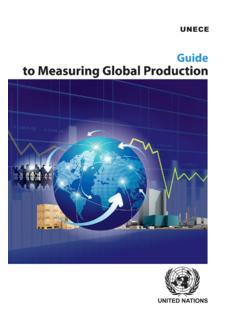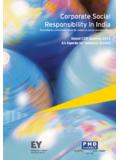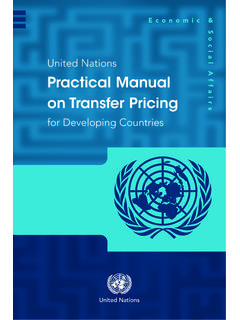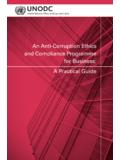Transcription of Chapter 5 Transfer Pricing Methods - United Nations
1 Agenda Item 5 Working Draft Chapter 5 Transfer Pricing Methods [This paper is based on a paper prepared by Members of the UN Tax Committee s Subcommittee on Practical Transfer Pricing Issues, but includes some Secretariat drafting and suggestions not yet considered by them the Secretariat takes responsibility for any relevant errors and omissions. Formerly, Methods were dealt with in Chapters 4 and 5, which are now combined hence the reference, on a temporary basis, to Parts 5A and 5B of this paper]. [Table of Contents to be added] Chapter 5A Traditional Methods 1. Introduction This part of the Chapter describes several Transfer Pricing Methods that can be used to determine an arm s length price and it describes how to apply these Methods in practice.
2 In general, the OECD Transfer Pricing guidelines are followed, with emphasis on practicality solutions when using and applying Transfer Pricing Methods . In response to practical difficulties that may exist in applying the OECD TP guidelines , for example when no access to databases with relevant information on comparables are readily available, some requirements for applying the arm s length standard are softened or more flexibly applied, [and some deviations/departures are suggested from the OECD TP guidelines in this Chapter . These deviations/ departures from the OECD TP guidelines may assist with allowing governments Page 2 of 65 and taxpayers in UN Member Countries to gain experience with the application of Transfer Pricing Methods while seeking ways to get more conformity with the OECD TP guidelines .]
3 ] Use of Methods In order to calculate or test the arm s length nature of prices or profits, use is made of Transfer Pricing Methods or methodologies. Transfer Pricing Methods are ways of calculating the profit margin of transactions or an entire enterprise or of calculating a Transfer price that qualifies as being at arm s length. The application of Transfer Pricing Methods is required to assure that transactions between associated enterprises conform to the arm s length standard. Please note that although the term profit margin is used, companies may also have legitimate reasons to report losses at arm s length. Furthermore, Transfer Pricing Methods are not determinative in and of themselves.
4 If an associated enterprise reports an arm s length amount of income, without the explicit use of one of the Transfer Pricing Methods recognized in the OECD Transfer Pricing guidelines , this does not mean that its Pricing is automatically not at arm s length and there may be no reason to impose adjustments. Selection of Methods (how, why and use of Methods ) Some Methods are more appropriate and indicative to provide for an arm s length result for certain transactions than others. For example, a cost based method is usually deemed more useful for determining an arm s length price for services and manufacturing, and a resale price based method is usually deemed more useful for determining an arm s length price for distribution/selling functions.
5 [The following overlaps with the Comparability Chapter to be synthesised] The starting point to select a method is the functional analysis which is necessary regardless of what Transfer Pricing method is selected. Each method may require a deeper analysis focusing on aspects in relation with the method. The functional analysis helps: Page 3 of 65 to identify and understand the intra group transactions, to have a basis for comparability to determine any necessary adjustments to the comparables, to check the accuracy of the method selected and over time, to consider adaptation of the policy if the functions, risks or assets have been modified. As such the functional analysis is a major part of the documentation.
6 The major components of a functional analysis are: Functions performed: It describes the activities performed such as design, purchasing, inbound logistics, manufacturing, R&D, assembling, inventory management, outbound logistics, marketing and sales activities, after sale services, supporting activities, services, advertising, financing and management, etc. It must be specified which party performs each activity and in case both parties are involved in performing an activity it should provide for the relevant differences; for example both have inventories but Company A holds inventories for a period of up to 2 years whereas company B only holds inventories for a period of 1 month.
7 The activities that add most value must be identified and be discussed more in detail. Risks undertaken: The functional analysis should identify risk undertaken. Examples are: financial risk (currency, commodity, interest rate, funding risks ), credit and collection risk (trading credit risk, commercial credit risk), operational risk ( systems failure risk, reliability of customers, inventory risk and carrying costs, R&D risk, environmental and other regulatory risks), market risk ( country political risk, reliability of customers, fluctuation in demand and prices), product risk ( product liability risk, warranty risk and costs, contract enforceability). A risk bearing party should have a chance of higher earnings than a non risk bearing party, and will incur the expenses and perhaps related loss if and when risk materializes.
8 Page 4 of 65 Assets used or contributed: the functional analysis must identify and distinguish tangible assets and intangible assets. Tangible assets such as a property, plant and equipment have to be financed and capital assets would usually be expected to earn a long term rate commensurate with the business risk assumed. Some assets could be specific and must be identified and quantified whenever possible. It should be specified which party bears the risk in the legal terms and which party bears the risk based on the economic substance of the transaction. Intangible assets are very important as sustainable competitive advantage is often achieved by the use of intangible assets.
9 Some intangibles have legal protection (patents, trademarks, trade names) but others without legal protection may be equally important and valuable (know how, trade secrets, corporate goodwill, exclusive import or export rights, etc). A party that developed the intangibles should be able to obtain benefit from the intangibles either through a sale or licensing of the intangibles or through an increase in prices of products or services with imbedded intangibles. It is important to determine which party has developed the intangibles and in what capacity, which has the legal ownership and which receives the benefit of the intangibles. Today in a multinational group, operations tend to be more integrated and functions, risks and assets are often shared.
10 The functional analysis provides answers to identify which functions risks and assets are attributable to the various related parties. In some cases one company may perform one function but the cost thereof is incurred/ paid by the other party to the transaction. The functional analysis could emphasise that situation. The functional analysis includes reference to the industry specifics, the contractual terms of the transaction, the economics circumstances and the business strategies. The functional Page 5 of 65 analysis helps to identify if the operations are complex justifying a higher level of profit or more limited and consequently generating a lower profit. A checklist with columns for each related party and if needed for the comparable parties could be used to summarize the functional analysis and give a quick idea of which party performs each relevant function, uses what assets and bears which risk.










![20 2011 10 1 P -:HSTCQE=VVZW][ - OECD.org - OECD](/cache/preview/e/e/2/6/b/1/b/c/thumb-ee26b1bc3ac51fe82000b356cddeac23.jpg)






